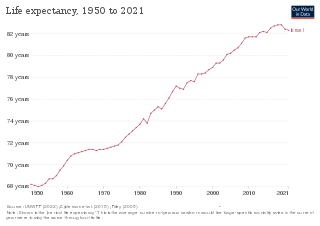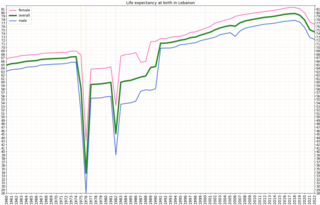
Tobacco is the common name of several plants in the genus Nicotiana of the family Solanaceae, and the general term for any product prepared from the cured leaves of these plants. More than 70 species of tobacco are known, but the chief commercial crop is N. tabacum. The more potent variant N. rustica is also used in some countries.

A cigarette is a narrow cylinder containing a combustible material, typically tobacco, that is rolled into thin paper for smoking. The cigarette is ignited at one end, causing it to smolder; the resulting smoke is orally inhaled via the opposite end. Cigarette smoking is the most common method of tobacco consumption. The term cigarette, as commonly used, refers to a tobacco cigarette, but the word is sometimes used to refer to other substances, such as a cannabis cigarette or a herbal cigarette. A cigarette is distinguished from a cigar by its usually smaller size, use of processed leaf, different smoking method, and paper wrapping, which is typically white.

Tobacco smoking is the practice of burning tobacco and ingesting the resulting smoke. The smoke may be inhaled, as is done with cigarettes, or simply released from the mouth, as is generally done with pipes and cigars. The practice is believed to have begun as early as 5000–3000 BC in Mesoamerica and South America. Tobacco was introduced to Eurasia in the late 17th century by European colonists, where it followed common trade routes. The practice encountered criticism from its first import into the Western world onwards but embedded itself in certain strata of a number of societies before becoming widespread upon the introduction of automated cigarette-rolling apparatus.

A hookah, shisha, or waterpipe is a single- or multi-stemmed instrument for heating or vaporizing and then smoking either tobacco, flavored tobacco, or sometimes cannabis, hashish and opium. The smoke is passed through a water basin—often glass-based—before inhalation.

Prevalence of tobacco use is reported by the World Health Organization (WHO), which focuses on cigarette smoking due to reported data limitations. Smoking has therefore been studied more extensively than any other form of consumption.

A menthol cigarette is a cigarette infused with the compound menthol which imparts a “minty” flavor to the smoke. Menthol also decreases irritant sensations from nicotine by desensitizing receptors, making smoking feel less harsh compared to regular cigarettes. Some studies have suggested that they are more addictive. Menthol cigarettes are just as hard to quit and are just as harmful as regular cigarettes.
As for many developing countries, health issues in Iran stem from a variety of reasons: namely, water and sanitation, diet and fitness, various addictions, mental fitness, communicable diseases, hygiene and the environment.

Health in Israel is generally considered good.

Smoking in Japan is practiced by around 20,000,000 people, and the nation is one of the world's largest tobacco markets, though tobacco use has been declining in recent years.
Tobacco has a long cultural, economic, and social history in the United States. Tobacco cultivation near Jamestown, Virgina Colony, in 1610 was the beginning of the plant's development as a cash crop with a strong demand in England. By the beginning of the 18th century, tobacco became a significant economic force in the American colonies, especially in Virginia's tidewater region surrounding Chesapeake Bay. Vast plantations were built along rivers, and socioeconomic systems were developed to grow and distribute the crop. In 1713, the Virginia General Assembly passed a Tobacco Act requiring the inspection of all tobacco intended for export or for use as legal tender. American tobacco farmers sold their crops on consignment to merchants in London, which required them to take out loans for farm expenses from London guarantors in exchange for tobacco delivery and sale. As the demand for tobacco grew in continental Europe, further colonization and tobacco production in British America saw a parallel increase, and tobacco cultivation spread into Britain's other Southern Colonies and beyond. A brisk trade developed among wholesalers in Charleston and New Orleans to ship tobacco to London merchants. Tobacco use had also become common in early American society and was heavily consumed before and after the declaration of American independence in 1776.

Tobacco smoking has serious negative effects on the body. A wide variety of diseases and medical phenomena affect the sexes differently, and the same holds true for the effects of tobacco. Since the proliferation of tobacco, many cultures have viewed smoking as a masculine vice, and as such the majority of research into the specific differences between men and women with regards to the effects of tobacco have only been studied in-depth in recent years.
Smoking in China is prevalent, as the People's Republic of China is the world's largest consumer and producer of tobacco. As of 2022, there are around 300 million Chinese smokers, and 2.4 trillion cigarettes are sold there every year, 46% of the world total.

Smoking in the United States military has been observed in previous wars, but smoking's close association with the United States military started in World War I when tobacco companies began to target military personnel through the distribution of cigarettes to servicemen and the eventual inclusion of cigarettes into rations. Although the military has attempted to implement tobacco control initiatives, the association between smoking and military personnel has persisted to the present day as smoking rates remain high, despite declines in civilian rates. Such high rates have led to questions about the effect of smoking from the apparent health risks to troop readiness and training costs.
Smoking in South Korea has decreased overall for both men and women in the past decades. However, a high prevalence of tobacco use is still observed, especially with the rise of novel tobacco products such as e-cigarettes and heat-not-burn tobacco products. There are socioeconomic inequalities in smoking prevalence according to gender, income, education, and occupational class. Advocates call for measures to reduce the smoking rates and address smoking inequalities using a combination of monitoring and tobacco control policies. These measures include significant price hikes, mandatory warning photos on cigarette packs, advertising bans, financial incentives, medical help for quitting, and complete smoking bans in public places.

Smoking in Albania is prevalent as about 40% of Albanians smoke regularly. In Europe, only Turkey has a higher smoking rate than Albania. Albanians annually spend more than €300 million on tobacco products. Zog I of Albania was reported to smoke 200 cigarettes a day. Albania adopted tough anti-smoking laws in 2007, but they are not strictly enforced. Smoking prevalence is increasing, especially among females ages 13 to 15. The smoking rate for teens between the ages of 13 and 15 is currently 15%.

Smoking in India is one of the oldest industries and provides employment to more than five million people directly and indirectly. India is the second-largest producer of tobacco in the world. Smoking has been known since at least 2000 BC when cannabis was smoked and is first mentioned in the Atharvaveda. Fumigation (dhupa) and fire offerings (homa) are prescribed in the Ayurveda for medical purposes and have been practiced for at least 3,000 years while smoking, dhumrapana has been practiced for at least 2,000 years. Tobacco was introduced to India in the 17th century. It later merged with existing practices of smoking.

Lebanon is a small middle-income country on the Eastern Mediterranean shore with a population of around 4 million Lebanese citizens, 1.2 million Syrian refugees, and half a million Palestinian refugees. It is at the third stage of its demographic transition characterized by a decline in both fertility and mortality rates. Moreover, Lebanon, like many countries in the Middle East is experiencing an epidemiological transition with an increasingly ageing population suffering from chronic and non-communicable diseases. Mortality related to non-communicable diseases is 404.4 deaths per 100,000 individuals, with an estimate of 45% due to cardiovascular diseases, making them the leading cause of death in Lebanon. Lebanon has health indices that are close to those of more developed countries, with a reported life expectancy at birth of 80.1 years and an under-five mortality rate of 9.5 per 1,000 live births in 2016. Since the end of the 15-year Lebanese Civil War in 1990, Lebanon’s health indicators have significantly improved.

Tobacco smoking is popular in North Korea and culturally acceptable among men, but not for women. As of 2019, some 43.6% of men are reported to smoke daily, whilst in contrast only 4.5% of women smoke daily, with most of these being older women from rural areas. Smoking is a leading cause of death in North Korea, and as of 2021 mortality figures indicate that 14.2% of North Koreans die due to smoking-related causes, which is the 6th highest rate after China, Greenland, Kiribati, Denmark and Micronesia. There are tobacco control programs in North Korea, and although smoking was not prohibited in all public spaces, the smoking rates have declined since their peak in the 2000s.

Tobacco policy in Armenia is the attempt by the Armenian authorities to regulate smoking in Armenia. Tobacco laws and regulations are controlled by the Ministry of Health of Armenia. Armenian men tend to be the most common tobacco users, as 42.5% of men over the age of 15 smoke.
Smoking in Latvia is common, with a rate higher than the OECD average, and Latvian men are among the heaviest smokers in the European Union. One in four Latvians smoke, as compared to one in five in the rest of the European Union. While the overall smoking rate in Latvia has decreased in recent years, it is considered a significant factor in the country's significant health challenges, particularly with regard to preventable diseases such as heart disease, diabetes, and cancer.













